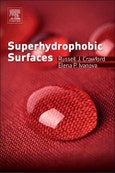Superhydrophobic Surfaces analyzes the fundamental concepts of superhydrophobicity and gives insight into the design of superhydrophobic surfaces. The book serves as a reference for the manufacturing of materials with superior water-repellency, self-cleaning, anti-icing and corrosion resistance. It thoroughly discusses many types of hydrophobic surfaces such as natural superhydrophobic surfaces, superhydrophobic polymers, metallic superhydrophobic surfaces, biological interfaces, and advanced/hybrid superhydrophobic surfaces.
Please Note: This is an On Demand product, delivery may take up to 11 working days after payment has been received.
Table of Contents
1. The concept of superhydrophobicity 2. Natural superhydrophobic surfaces 3. Soil wettability 4. Superhydrophobic polymers 5. Metallic superhydrophobic surfaces 6. Insights into the design of superhydrophobic surfaces 7. Biological interfaces 8. Advanced /hybrid superhydrophobic surfaces








